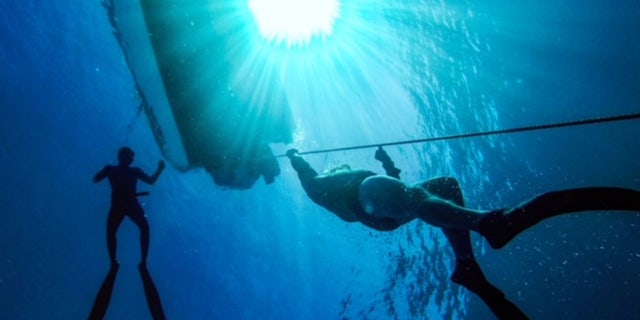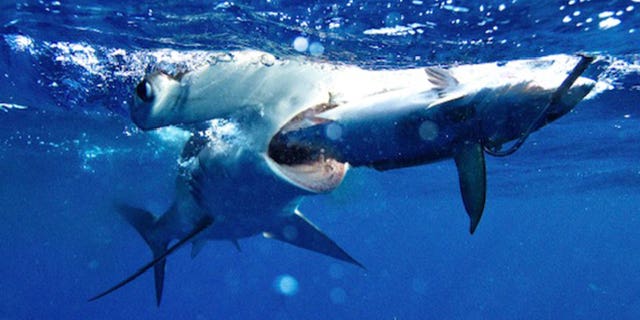Shark attacks or bites don’t occur as often as people fear they do. The odds of being attacked and killed by a shark are extremely low, 1 in 3.7 million to be exact, according to PETA’s website.
While the likelihood of receiving a bite or being attacked by a shark is low, more than 50% of Americans fear both the fish and the situation, according to a 2015 study.
“People shouldn’t fear sharks,” said Rick Sorensen, boat captain and professional open water diver, “That’s the wrong mindset.”
SHARK ATTACK SURVIVOR IS ON A MISSION TO PROTECT THESE ANIMALS: ‘FEAR CAN BE A POWERFUL MOTIVATOR’
Sorensen grew up in Pompano Beach, Florida, and has been certified since 1976. He is an expert in a number of water activities, including blue-water, scuba and free diving, as well as spearfishing, snorkeling and surfing. Sorensen has had both exposure to sharks and different confrontations with them.
Coming in contact with a shark is a possibility if you’re swimming in their home but the worst thing you can do in the situation is panic. (Rick Sorensen)
“You don’t need to be fearful of any sharks because that’s going to cause panic,” he told Fox News Digital. “That’s the only reason I say don’t be fearful of sharks.”
While Sorensen believes it’s instinctual to be frightened by something that can eat you or bite you, he says being afraid and panicking will trigger a shark to become interested in you as prey, and it might not have been in the first place.
“I’ve had sharks try to take food from me,” he said. “Sometimes, I’ll just throw it to them.”
Where and when are shark attacks most likely to occur?
Shark attacks are more prevalent in the Atlantic Ocean vs the Pacific, according to National Geographic.
In the U.S., attacks occur most often in Florida. Of the 47 total U.S. shark attacks in 2021, 28 of them happened in the Sunshine State, according to the World Animal Foundation. Hawaii, California, South Carolina, North Carolina, Georgia and Maryland have also been known for an occasional shark attack. The six states combined recorded 19 total shark attacks in 2021.
Internationally, you should be aware of sharks in Australia, Brazil and off the coast of South Africa in Gansbaai.
“Sharks attacks on surfers and swimmers are usually due to a mistaken identity,” said Sorensen. “It happens more when a lot of fish are present and the water is murky.”
Early mornings and late evenings are times to avoid being in the water, especially alone. These times of day are low light situations that create visibility problems for predators in the water.
“Which is why fishing is so good in the morning and fishing is so good in the evening,” Sorensen said. “The outline of the bait isn’t as clear.”
Clear water gives sharks plainly defined outlines of a human and people are not typically part of a shark’s eating patterns. Sorensen says humans don’t fit the profile of a shark’s regular diet. They typically eat fish, marine mammals, including seals, crustaceans and molluscs.
GREAT WHITE SHARK SPOTTED FEASTING ON SEAL CARCASS NEAR CAPE COD
“When you have an extreme situation, maybe in a place a shark is used to feeding, and it doesn’t have a food source there anymore whether due to human interference,” said Sorensen, “then the food situation for the predators is at a critical level and maybe the predator is going to try to expand its diet.”
Sorensen, though a fearless professional diver with enough shark encounters for one lifetime, recommends swimming no farther than 10 yards out from the beach.
“Why would a person want to swim 100 yards from the beach? This blows my mind,” he said. “That’s being ignorantly unaware.”
While shark bites and attacks can occur just a few feet out from the beach, swimming much farther out puts you immeasurably more at risk of an attack. Swimming far into the deep waters also puts you at a greater distance to land in case of a sighting, bite or attack.
Provoked vs unprovoked shark attacks
Provoked shark attacks are when a human does something to interact with a shark and then receives a bite and injury, or dies. Unprovoked shark attacks are when a person does nothing to interact with a shark but receives a potentially fatal interaction anyway.
There are three types of shark attacks: hit-and-run, bump-and-bite and sneak attacks.
In a hit-and-run, sharks will inflict a single bite or slash, leave and not return. They often mistake humans for prey and once they realize the human is not the food they’re looking for, revert into the water, according to the Florida Museum.
“Sometimes shark attacks happen, and it’s a mistake,” Sorensen said. “The profile of a surfer on a surfboard looks like a seal.”
Bump-and-bite attacks occur when the shark warns the human prey by bumping into them before attacking. These attacks are often fatal.
Sneak attacks are when the shark charges without warning. In both occurrences, sharks are more likely to attack again vs. a hit-and-run attack.

If you intend on swimming with sharks, whether knowingly or unknowingly, you must be aware of your surroundings at all times. (Rick Sorensen)
“If you do have a shark on you, and it’s got ahold of your arm, you need to punch it, you need to kick it, and fight it,” Sorensen said. “Just blunt force.”
Sorensen recommends fighting the shark off with blows to the nose, the side of the head, or the eyes if possible. Use whatever strength you have or employ water sport objects like a surfboard or a water ski and make your way back to shore.
“What are you going to do? Are you going to give up or fight? It’s a fight or flight situation,” he said. “A person doesn’t really know which they’re going to choose unless they’re in that situation.”
SURVIVOR DESCRIBES NEAR-DEADLY SHARK ATTACK
How can I identify dangerous sharks?
White sharks, tiger sharks and bull sharks are the “Big Three” you should be aware of. White sharks have historically had the greatest number of human bites.
White sharks are considered the most dangerous sharks and can grow up to 20 feet. Their dorsal fin is located at the top of the shark and would be visible if the shark were swimming close to the water’s edge. While you’re likely not going to slowly examine a shark if it approaches you to determine the type, often white sharks can be identified by the shape of their dorsal fin.
Tiger sharks are dark brown with white bellies, and have more flat, wide faces than pointy heads. While tiger sharks are named for their tiger stripes, they fade as they get older. They do, however, also have a dorsal fin that can be seen above the water if close enough to the surface.
“If a tiger shark bites a person, it doesn’t have any problem getting through the bones. It’s designed to cut through bone,” Sorensen said of the shark’s double-serrated teeth that are strong enough to gash through a turtle’s shell.
Bull sharks are a grayish brown with a light, white belly. Bull sharks are difficult to identify, according to National Geographic. They are identifiable by their stocky shape as they are shorter and wider than white sharks and tiger sharks.

People are not typically a shark’s prey. If food sources are low for sharks, the fish are more inclined to eat humans as they’re hungry. (Rick Sorensen)